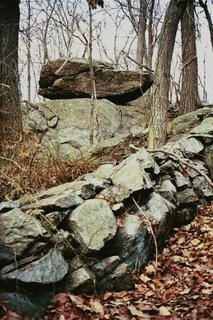By Geophile
You're probably familiar with the stone in the above picture. Although I didn't get to see it (and photograph it with my son, Jonas, pretending to push it off its supports) until a couple years ago, it was one of the pivots in the curvy track that brought me to the interest in the stones that I have today. I was always interested in Stonehenge and Avebury, but when this stone appeared on the cover of an album by one of my favorite musicians at the time, Robin Williamson, with a reference to Fell's America B.C., it started me on the trail of stonework here on our continent.
Of course, at first I thought it was Celtic. I now know that the Celtic people did not erect megalithic monuments at all, that the monuments on the lands they inhabited had been built millennia before the arrival of Celtic culture, by people who are less well known. At the time, however, the idea inspired me.
One day, I was on an amazing lookout at the top of the nearby ridge, a lookout I'd hiked to many times before, when I noticed that the way one large stone was balanced on two smaller ones, with room to crawl beneath, was unlikely to have happened naturally. I don't have a picture of that propped rock now, and it has since been toppled. When two people separately sent me a newspaper article about a shoe store owner who lectured on local stonework sites, I went to him to tell him about the stones at the lookout, and that was the first time I spoke with Mr. Werkheiser about the stones. I didn't know at that point that I would meet him again years later and have a chance for many further discussions.
I give that bit of history partly to show that propped boulders, probably more than rockpiles, can get the attention of someone who comes from outsidethe realm of stonework enthusiasts. Big stones balanced on little ones seem 'funny,' and make people curious. Sometimes, though, you can walk right by them and not notice. The one above was probably only nine feet long and three or four across, and the stones under it were small. I might not have noticed that it was propped if I hadn't noticed that it was blackened underneath, as I'd seen other rocks at other sites. Of course the blackness could have happened a number of ways, but it made me take notice. And now I wonder how many inconspicuous propped boulders I've overlooked at other sites.
As for the question of whether they were placed that way by glaciers or man, we can only guess. To quote a website on related topics in the U.K., "Whilst acknowledging that the distinction between a stone that has been moved by human agency, and one that has not, is important for interpretation this does not make it more or less culturally significant." The fact that they are so often found close to other stonework or near sites of wide landscape views or other points of interest in the landscape suggests that they had some significance.
Perched boulders are related to propped boulders. Perched boulders often appear as elements at larger sites, frequently in shapes that suggest a totem animal. If it were true, as some theorize, for example, that the Oley Hills site represents some kind of Lenape territorial boundary or corner, then the dog or wolf head-shaped perched boulder above and the turtle shell-shaped perched boulder below could have important meanings.
The boulder below was at a site in Monroe County, poised on a hill above a large field of rockpiles, now partially destroyed. As is frequently but certainly not always the case, the perched boulder here is a different color from the rock on which it's perched.
At the same site, the enormous propped boulder below formed a rock shelter just below the top of the hill. Except for the North Salem boulder, all of the above boulders are at sites that also feature both walls and rockpiles. Tripod Rock at Kinnelon, another outstanding propped boulder, is said to be near walls and rockpiles, too.
I'm curious about boulders at rockpile sites. More than once I've noticed interesting characteristics of a boulder by looking at a photograph later. I would enjoy any such pictures any of you out there might be willing to send to me.
We still may not be seeing all the secrets right before our eyes.
Subscribe to:
Post Comments
(
Atom
)






1 comment :
The perched boulders at the Oley Hills site are not glacial erratics but rather tors, which are remnants of outcrops that have weathered in place. The Wisconsin glacier ended its southern movement some twenty miles to the north, and this should be kept in mind whenever one is studying perched boulders in the Pennsylvania area. Maps are available online that show just where the glacier stopped, and boulders below that line should be studied very carefully, especially if they reveal small support stones underneath.
Interesting what you say about the second Oley Hills photo reminding you of a turtle, since within sight of this outcrop is a turtle effigy.
Post a Comment